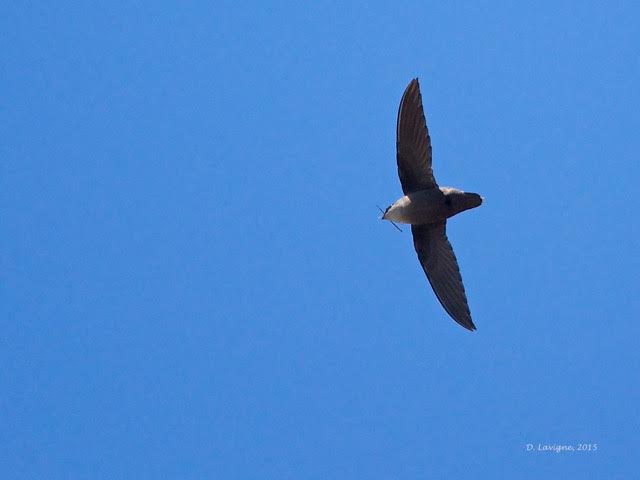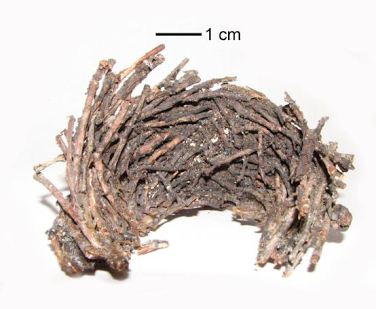There is an old adage “Use a picture. It is worth a thousand words”. Believing in this approach, this exquisite photograph of a chimney swift carrying a twig in it’s beak, is worth a million.
PHOTO CREDIT: DAVE LAVIGNE
Dave Lavigne took this incredible photograph on June 3, 2015, at approximately 2:20 PM, near St. George’s Anglican Church which is located on North Street, Goderich, ON. THANK YOU Dave for sharing this photo with us all!
The backstory: Rob and I were in downtown Goderich last June with Dave and his wife Sue. We discovered that St. George’s chimney was a roost site occupied by at least 180 chimney swifts. A smaller brick chimney in a nearby home was identified as an active site also; it was likely a nest site as the entry Rob witnessed was before the roosting hour on a clear, warm evening. Dave is now the chimney swift steward of St. George’s and after he contacted Diana Teal (our MCSI coordinator of last fall who relocated to Ontario and now manages the Ontario SwiftWatch program), this new site was listed in the Ontario database maintained by Bird Studies Canada. The only previously known roost in Goderich was at Bluewater Cleaners, 38 West Street. Unfortunately, a devastating tornado in 2011 damaged that sector of Goderich. There is now a new roof but no chimney on the building at 38 West Street, however, chimney swifts are still being observed in the area by Dave (June, 2015).
The photo: the chimney swift is carrying a short, small diameter twig in it’s beak. The twig would be used for nest building. The featured swift is a breeding adult with a nest site closeby. Dave’s highly informative photo also shows many diagnostic features of a chimney swift:
-
the body is cigar shaped (perhaps we need to find a new adjective that is more appropriate for the new non-smoking world we live in; zeppelin shaped?).
-
the wings are long. When swifts are soaring with the classic “boomerang-shaped” or “sickle-shaped” wing position, it is easy to see that the wings extend well past the end of the tail. Chimney swifts cannot get up off the ground easily due to their long wings and the configuration of their clinging-adapted feet.
-
the feet are held tightly to the body and are not obvious (giving rise to the Family designation of Apodidae – without feet). Because the hallux or rear toe faces forward to improve clinging onto rough vertical surfaces, chimney swifts cannot perch on branches or wires etc.
-
the tail feathers are very short and bristles project from the ends (one appears shiny white). The stiff bristles are pushed against a vertical surface for extra stability when a swift rests/roosts.
-
the wings are bowed – curving to the rear.
-
the trailing wing margin is intact; later in the season, as moulting occurs, you will notice gaps or discontinuities created by missing feathers.
-
the swift is sooty grey with a lighter throat patch.
Nest building in Manitoba begins shortly after the spring migrants arrive. So, there is between year variation in the date of onset, but nest building typically starts around May 22 (range is May 10 for early arrivals to June 25 for late arriving pairs)(see Stewart and Stewart 2013 –
http://www.mbchimneyswift.ca/Documents/2013_BlueJay.pdf ). The spring arrival of the swifts was delayed by poor weather in 2015 and your monitoring data showed nest building was off to a slow start.
Chimney swift nests are made from approximately 265 twigs which are glued together with the adult’s saliva and attached to a rough vertical surface (see Kyle and Kyle, 2005). The Kyle’s provide dimensions for nests: width = 3.5 to 4.5″; height = 1 to 1.25″; and distance from wall = 1.75 to 3″. A pair will collect and attach 8-12 twigs per day and after a week, the female starts to lay eggs (Kyle and Kyle, 2005). However, the nest cup is considerably undersized at this point so the pair continues to bring in nesting material through the incubation period (Kyle and Kyle, 2005).
The nests are attached at a considerable distance below the chimney rim e.g., at least 10′. In St. Adolphe, trees used for nest building e.g., Manitoba Maple, Ash, and Japanese Maple, are situated within 50 m of nest sites (http://www.mbchimneyswift.ca/Documents/MCSI_artificialstructures2015.pdf).
How do you know if chimney swifts are building a nest in a chimney? Watch the rim for an hour before the roosting hour! In addition to roosting activity, pairs of breeding chimney swifts enter and exit the site during the daytime. You will not always see the breeding pair travel together; they may enter or exit the site individually. The duration in the chimney and the between-visit interval varies considerably at 1 to 70 min and from 1 to 50 min, respectively (see Stewart and Stewart, 2010 – http://www.mbchimneyswift.ca/Documents/bluejay2010.pdf ).
Happy swifting, Barb Stewart for the rest of the MCSI Steering Committee – Christian Artuso, Ron Bazin, Neil Butchard, Lewis Cocks, Ken De Smet, Nicole Firlotte, Rob Stewart, our Habitat Stewardship and Outreach Coordinator Tim Poole (mcsi.outreach@gmail.com), and our webmaster Frank Machovec.


